lane assist MERCEDES-BENZ SPRINTER 2014 MY14 Operator’s Manual
[x] Cancel search | Manufacturer: MERCEDES-BENZ, Model Year: 2014, Model line: SPRINTER, Model: MERCEDES-BENZ SPRINTER 2014Pages: 338, PDF Size: 6.78 MB
Page 11 of 338
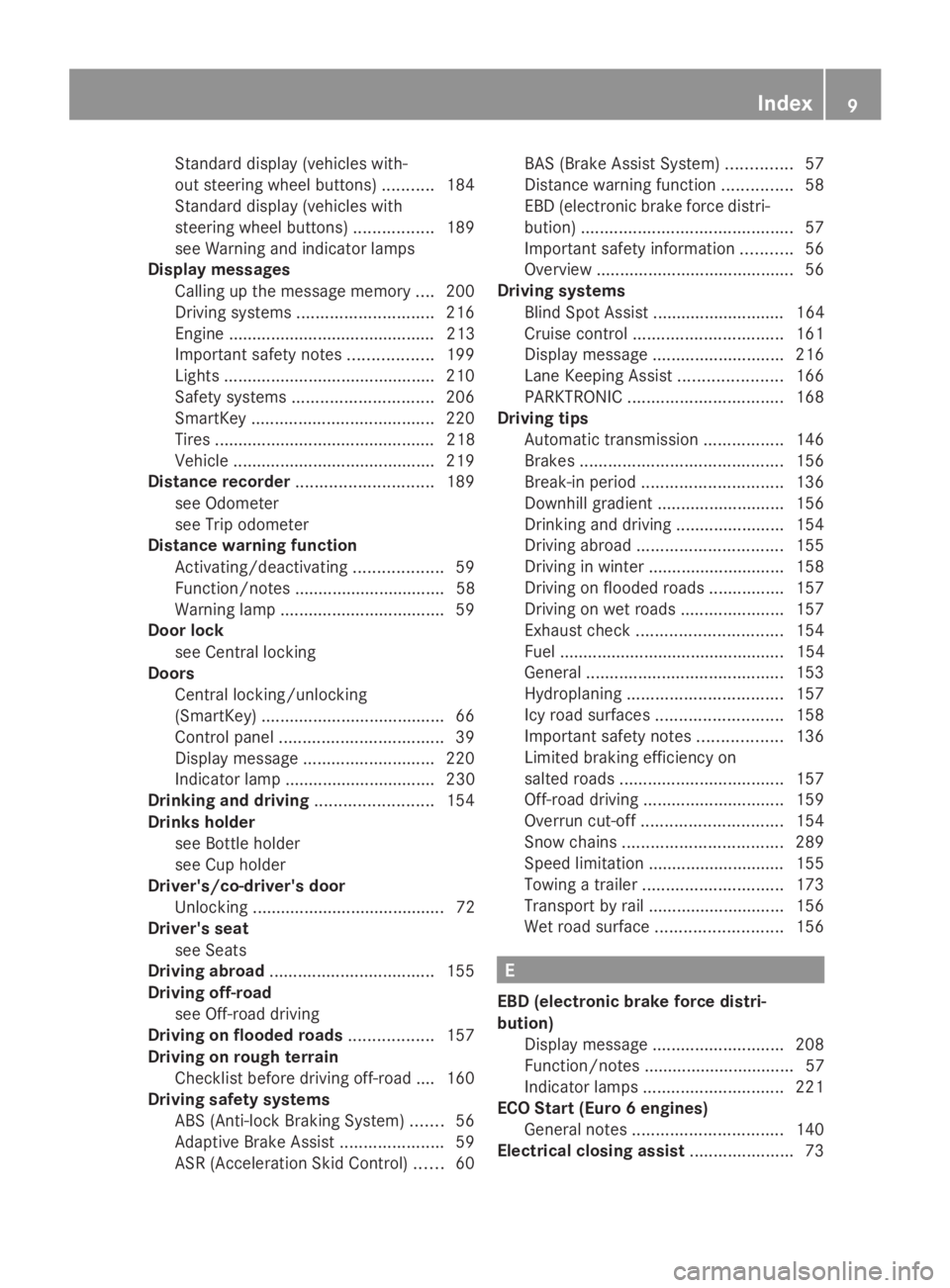
Standard display (vehicles with-
out steering wheel buttons)
...........184
Standard display (vehicles with
steering wheel buttons) .................189
see Warning and indicator lamps
Display messages
Calling up the message memory ....200
Driving systems ............................. 216
Engine ............................................ 213
Important safety notes ..................199
Lights ............................................ .210
Safety systems .............................. 206
SmartKey ....................................... 220
Tires ............................................... 218
Vehicle .......................................... .219
Distance recorder ............................. 189
see Odometer
see Trip odometer
Distance warning function
Activating/deactivating ...................59
Function/notes ................................ 58
Warning lamp ................................... 59
Door lock
see Central locking
Doors
Central locking/unlocking
(SmartKey) ....................................... 66
Control panel ................................... 39
Display message ............................ 220
Indicator lamp ................................ 230
Drinking and driving .........................154
Drinks holder see Bottle holder
see Cup holder
Driver's/co-driver's door
Unlocking ......................................... 72
Driver's seat
see Seats
Driving abroad ................................... 155
Driving off-road see Off-road driving
Driving on flooded roads ..................157
Driving on rough terrain Checklist before driving off-road .... 160
Driving safety systems
ABS (Anti-lock Braking System) .......56
Adaptive Brake Assist ......................59
ASR (Acceleration Skid Control )...... 60 BAS (Brake Assist System)
..............57
Distance warning function ...............58
EBD (electronic brake force distri-
bution) ............................................. 57
Important safety information ...........56
Overview .......................................... 56
Driving systems
Blind Spot Assist ............................ 164
Cruise control ................................ 161
Display message ............................ 216
Lane Keeping Assist ......................166
PARKTRONIC ................................. 168
Driving tips
Automatic transmission .................146
Brakes ........................................... 156
Break-in period .............................. 136
Downhill gradient ........................... 156
Drinking and driving .......................154
Driving abroad ............................... 155
Driving in winter ............................ .158
Driving on flooded roads ................157
Driving on wet roads ......................157
Exhaust check ............................... 154
Fuel ................................................ 154
General .......................................... 153
Hydroplaning ................................. 157
Icy road surfaces ........................... 158
Important safety notes ..................136
Limited braking efficiency on
salted road s................................... 157
Off-road driving .............................. 159
Overrun cut-off .............................. 154
Snow chains .................................. 289
Speed limitation ............................ .155
Towing a trailer .............................. 173
Transport by rail ............................ .156
Wet road surface ........................... 156 E
EBD (electronic brake force distri-
bution) Display message ............................ 208
Function/notes ................................ 57
Indicator lamps .............................. 221
ECO Start (Euro 6 engines)
General notes ................................ 140
Electrical closing assist ......................73 Index
9
Page 14 of 338
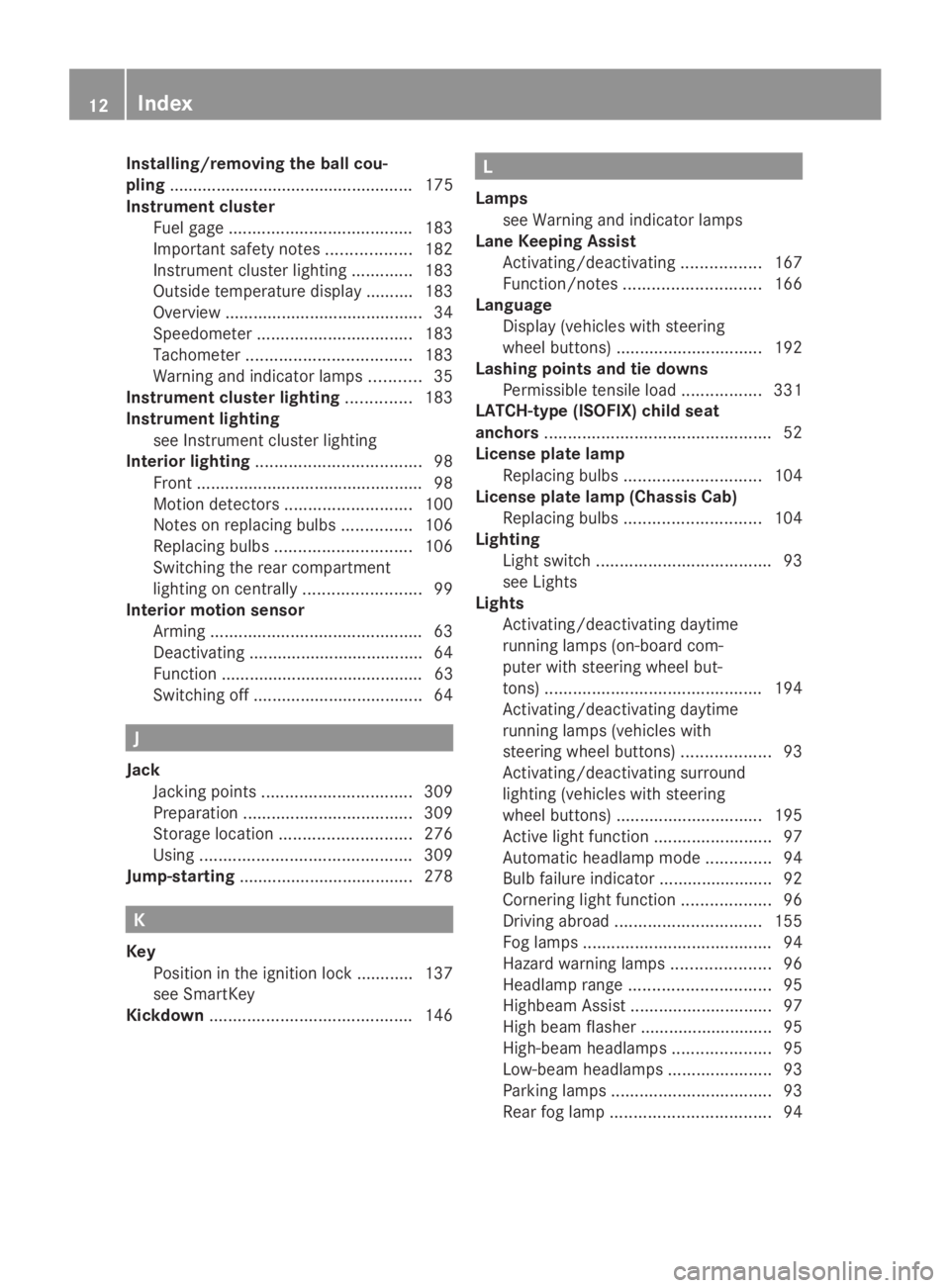
Installing/removing the ball cou-
pling
.................................................... 175
Instrument cluster Fuel gage ....................................... 183
Important safety notes ..................182
Instrument cluster lighting .............183
Outside temperature displa y.......... 183
Overview .......................................... 34
Speedometer ................................. 183
Tachometer ................................... 183
Warning and indicator lamps ...........35
Instrument cluster lighting ..............183
Instrument lighting see Instrument cluster lighting
Interior lighting ................................... 98
Front ................................................ 98
Motion detectors ........................... 100
Notes on replacing bulbs ...............106
Replacing bulbs ............................. 106
Switching the rear compartment
lighting on centrally .........................99
Interior motion sensor
Arming ............................................. 63
Deactivating .................................... .64
Function ........................................... 63
Switching off .................................... 64J
Jack Jacking points ................................ 309
Preparation .................................... 309
Storage location ............................ 276
Using ............................................. 309
Jump-starting ..................................... 278K
Key Position in the ignition lock ............ 137
see SmartKey
Kickdown ........................................... 146 L
Lamps see Warning and indicator lamps
Lane Keeping Assist
Activating/deactivating .................167
Function/notes ............................. 166
Language
Display (vehicles with steering
wheel buttons) ............................... 192
Lashing points and tie downs
Permissible tensile loa d................. 331
LATCH-type (ISOFIX) child seat
anchors ................................................ 52
License plate lamp Replacing bulbs ............................. 104
License plate lamp (Chassis Cab)
Replacing bulbs ............................. 104
Lighting
Light switch ..................................... 93
see Lights
Lights
Activating/deactivating daytime
running lamps (on-board com-
puter with steering wheel but-
tons) .............................................. 194
Activating/deactivating daytime
running lamps (vehicles with
steering wheel buttons) ...................93
Activating/deactivating surround
lighting (vehicles with steering
wheel buttons) ............................... 195
Active light function .........................97
Automatic headlamp mode ..............94
Bulb failure indicator ........................92
Cornering light function ...................96
Driving abroad ............................... 155
Fog lamps ........................................ 94
Hazard warning lamps .....................96
Headlamp range .............................. 95
Highbeam Assist .............................. 97
High beam flasher ............................ 95
High-beam headlamps .....................95
Low-beam headlamps ......................93
Parking lamps .................................. 93
Rear fog lamp .................................. 9412
Index
Page 38 of 338
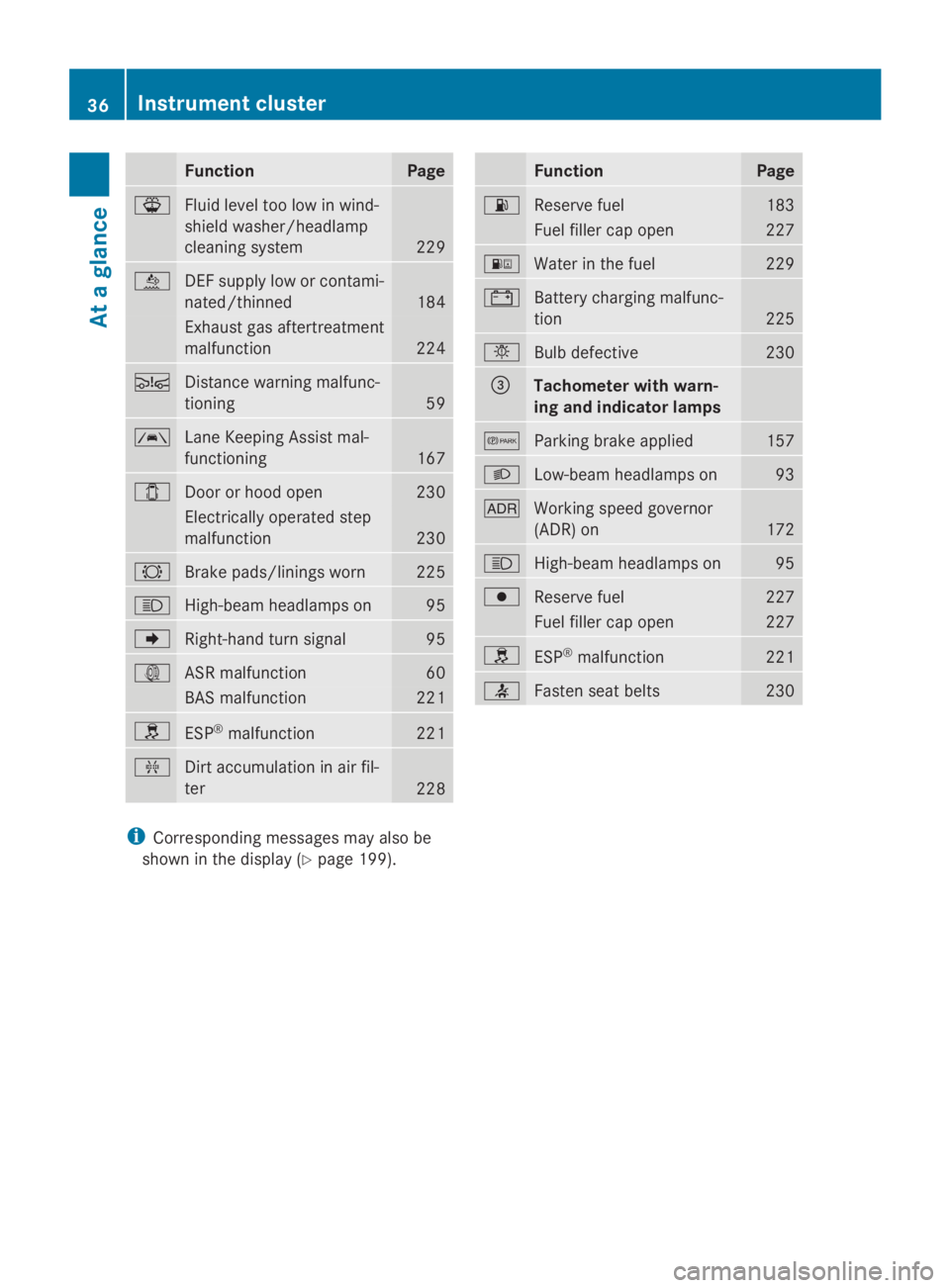
Function Page
00B1
Fluid level too low in wind-
shield washer/headlamp
cleaning system
229
00E2
DEF supply low or contami-
nated/thinned
184
Exhaust gas aftertreatment
malfunction 224
00C7
Distance warning malfunc-
tioning
59
00B0
Lane Keeping Assist mal-
functioning
167
003E
Door or hood open 230
Electrically operated step
malfunction 230
0026
Brake pads/linings worn 225
0057
High-beam headlamps on 95
004D
Right-hand turn signal 95
003D
ASR malfunction 60
BAS malfunction 221
0089
ESP
®
malfunction 221
009F
Dirt accumulation in air fil-
ter
228 Function Page
00B4
Reserve fuel 183
Fuel filler cap open 227
00B8
Water in the fuel 229
003D
Battery charging malfunc-
tion
225
0049
Bulb defective 230
0087
Tachometer with warn-
ing and indicator lamps 0066
Parking brake applied 157
0058
Low-beam headlamps on 93
004E
Working speed governor
(ADR) on
172
0057
High-beam headlamps on 95
0077
Reserve fuel 227
Fuel filler cap open 227
0089
ESP
®
malfunction 221
0076
Fasten seat belts 230
i
Corresponding messages may also be
shown in the display (Y page 199).36
Instrument clusterAt a glance
Page 40 of 338
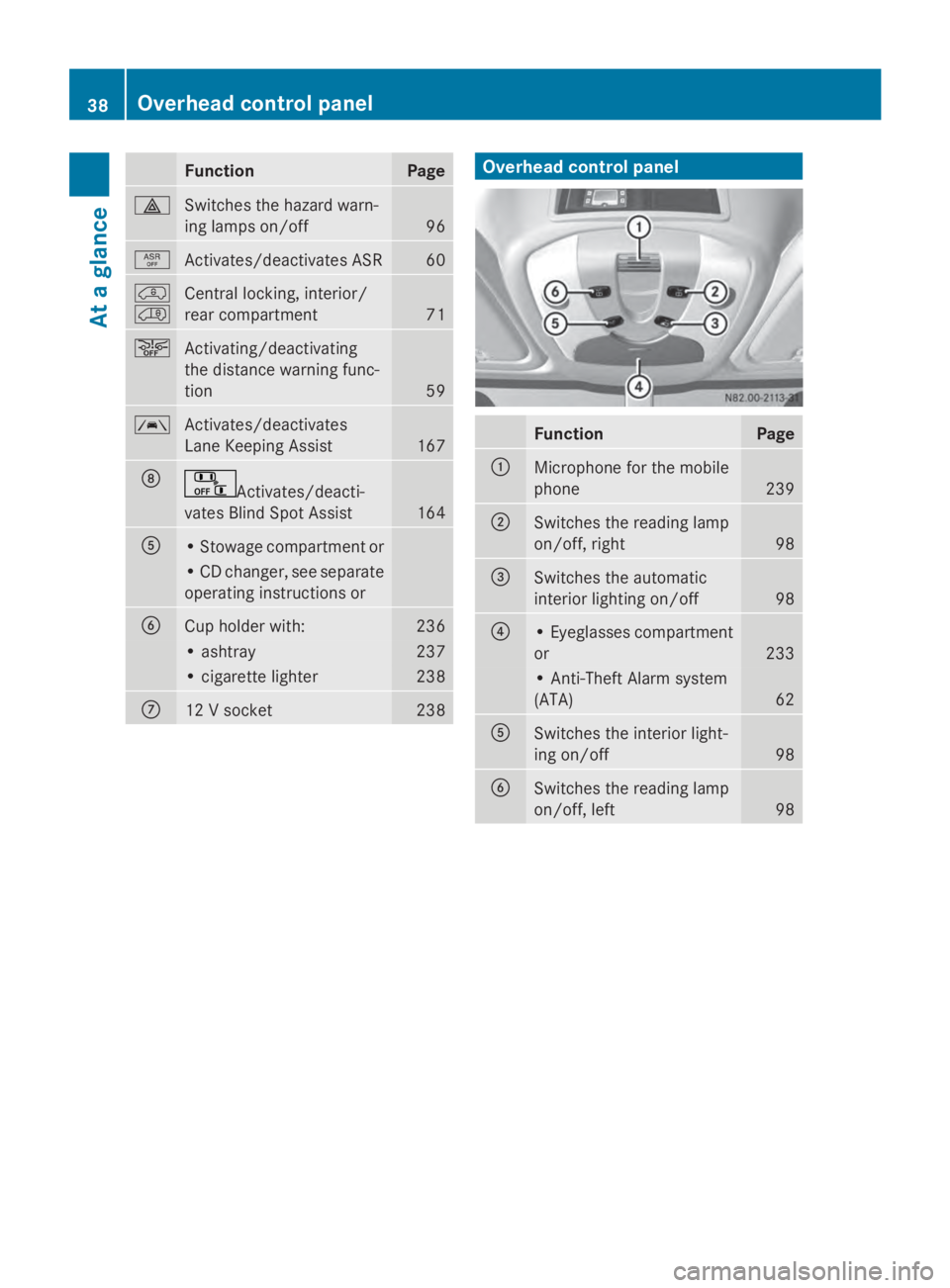
Function Page
002F
Switches the hazard warn-
ing lamps on/off
96
00E3
Activates/deactivates ASR 60
00BF
00C0
Central locking, interior/
rear compartment
71
00D4
Activating/deactivating
the distance warning func-
tion
59
00B0
Activates/deactivates
Lane Keeping Assist
167
006C
Activates/deacti-
vates Blind Spot Assist 164
0083
• Stowage compartment or
• CD changer, see separate
operating instructions or
0084
Cup holder with: 236
• ashtray 237
• cigarette lighter 238
006B
12 V socket 238 Overhead control panel
Function Page
0043
Microphone for the mobile
phone 239
0044
Switches the reading lamp
on/off, right 98
0087
Switches the automatic
interior lighting on/off 98
0085
• Eyeglasses compartment
or
233
• Anti-Theft Alarm system
(ATA)
62
0083
Switches the interior light-
ing on/off 98
0084
Switches the reading lamp
on/off, left 9838
Overhead control panelAt a glance
Page 166 of 338
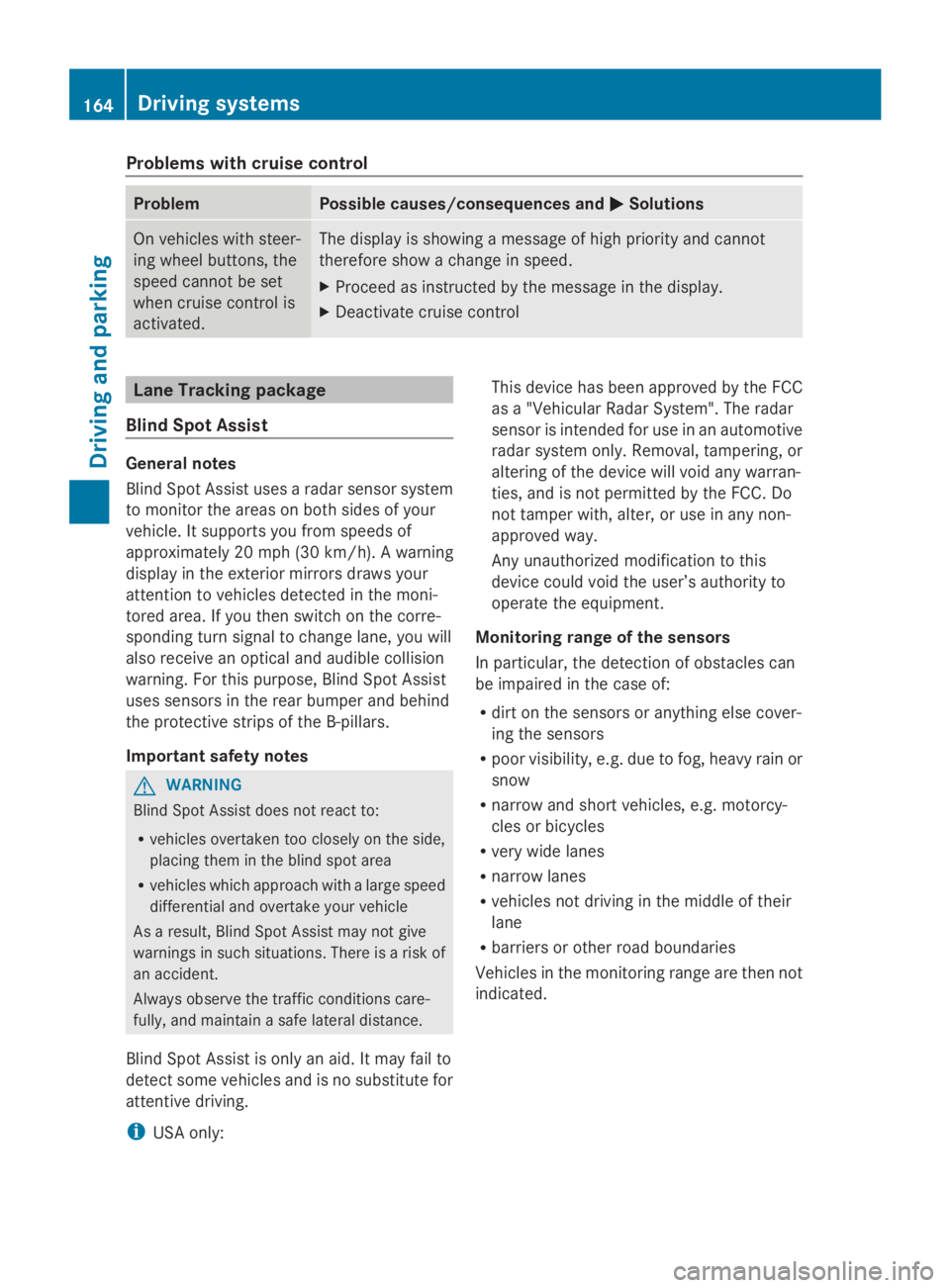
Problems with cruise control
Problem Possible causes/consequences and
0050
0050Solutions On vehicles with steer-
ing wheel buttons, the
speed cannot be set
when cruise control is
activated. The display is showing a message of high priority and cannot
therefore show a change in speed.
X
Proceed as instructed by the message in the display.
X Deactivate cruise control Lane Tracking package
Blind Spot Assist General notes
Blind Spot Assist uses a radar sensor system
to monitor the areas on both sides of your
vehicle. It supports you from speeds of
approximately 20 mph (30 km/h). A warning
display in the exterior mirrors draws your
attention to vehicles detected in the moni-
tored area. If you then switch on the corre-
sponding turn signal to change lane, you will
also receive an optical and audible collision
warning. For this purpose, Blind Spot Assist
uses sensors in the rear bumper and behind
the protective strips of the B-pillars.
Important safety notes G
WARNING
Blind Spot Assist does not react to:
R vehicles overtaken too closely on the side,
placing them in the blind spot area
R vehicles which approach with a large speed
differential and overtake your vehicle
As a result, Blind Spot Assist may not give
warnings in such situations. There is a risk of
an accident.
Always observe the traffic conditions care-
fully, and maintain a safe lateral distance.
Blind Spot Assist is only an aid. It may fail to
detect some vehicles and is no substitute for
attentive driving.
i USA only: This device has been approved by the FCC
as a "Vehicular Radar System". The radar
sensor is intended for use in an automotive
radar system only. Removal, tampering, or
altering of the device will void any warran-
ties, and is not permitted by the FCC. Do
not tamper with, alter, or use in any non-
approved way.
Any unauthorized modification to this
device could void the user’s authority to
operate the equipment.
Monitoring range of the sensors
In particular, the detection of obstacles can
be impaired in the case of:
R dirt on the sensors or anything else cover-
ing the sensors
R poor visibility, e.g. due to fog, heavy rain or
snow
R narrow and short vehicles, e.g. motorcy-
cles or bicycles
R very wide lanes
R narrow lanes
R vehicles not driving in the middle of their
lane
R barriers or other road boundaries
Vehicles in the monitoring range are then not
indicated. 164
Driving systemsDriving and parking
Page 167 of 338
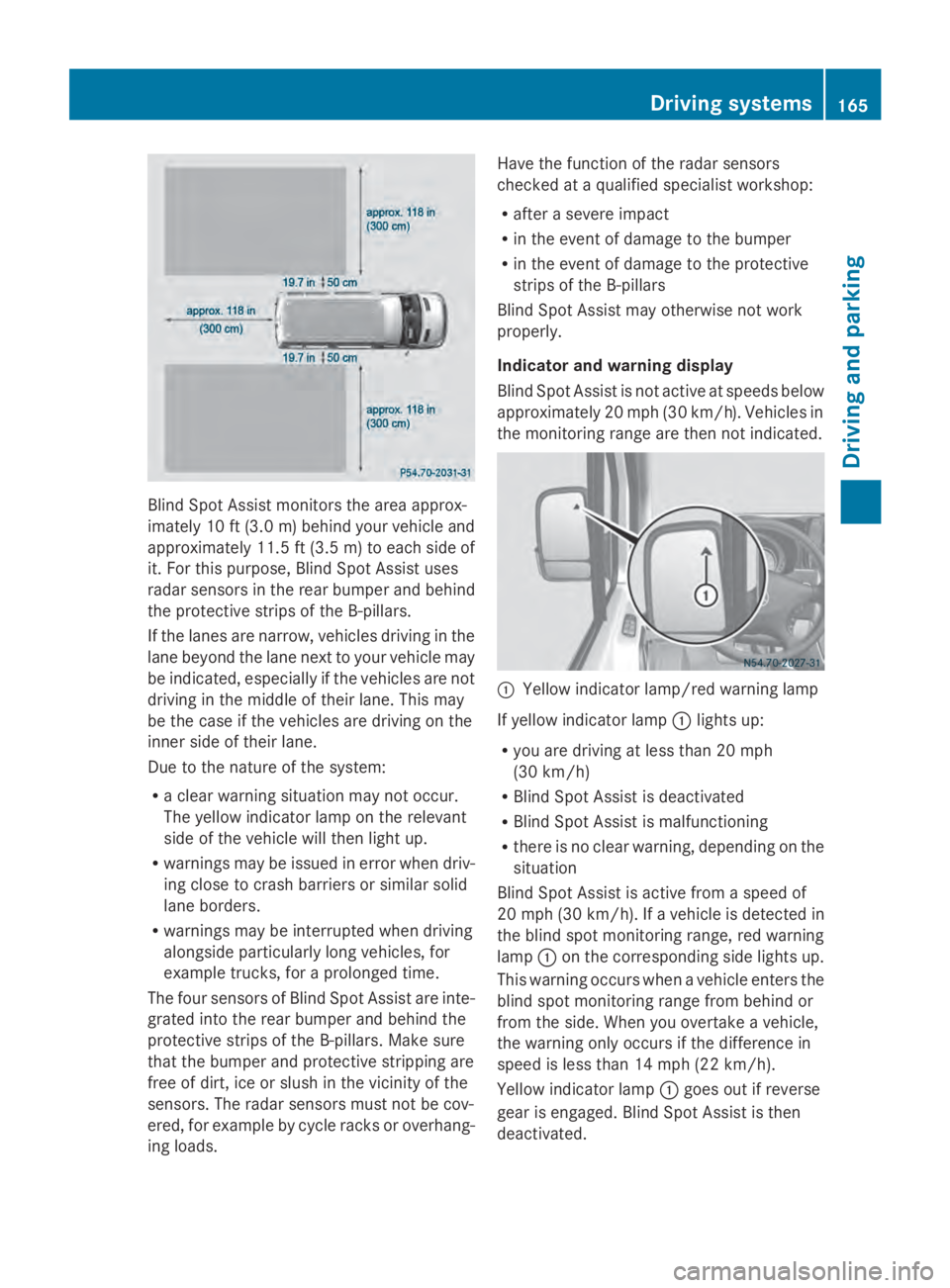
Blind Spot Assist monitors the area approx-
imately 10 ft (3.0 m) behind your vehicle and
approximately 11.5 ft (3.5 m) to each side of
it. For this purpose, Blind Spot Assist uses
radar sensors in the rear bumper and behind
the protective strips of the B-pillars.
If the lanes are narrow, vehicles driving in the
lane beyond the lane next to your vehicle may
be indicated, especially if the vehicles are not
driving in the middle of their lane. This may
be the case if the vehicles are driving on the
inner side of their lane.
Due to the nature of the system:
R a clear warning situation may not occur.
The yellow indicator lamp on the relevant
side of the vehicle will then light up.
R warnings may be issued in error when driv-
ing close to crash barriers or similar solid
lane borders.
R warnings may be interrupted when driving
alongside particularly long vehicles, for
example trucks, for a prolonged time.
The four sensors of Blind Spot Assist are inte-
grated into the rear bumper and behind the
protective strips of the B-pillars. Make sure
that the bumper and protective stripping are
free of dirt, ice or slush in the vicinity of the
sensors. The radar sensors must not be cov-
ered, for example by cycle racks or overhang-
ing loads. Have the function of the radar sensors
checked at a qualified specialist workshop:
R
after a severe impact
R in the event of damage to the bumper
R in the event of damage to the protective
strips of the B-pillars
Blind Spot Assist may otherwise not work
properly.
Indicator and warning display
Blind Spot Assist is not active at speeds below
approximately 20 mph (30 km/h). Vehicles in
the monitoring range are then not indicated. 0043
Yellow indicator lamp/red warning lamp
If yellow indicator lamp 0043lights up:
R you are driving at less than 20 mph
(30 km/h)
R Blind Spot Assist is deactivated
R Blind Spot Assist is malfunctioning
R there is no clear warning, depending on the
situation
Blind Spot Assist is active from a speed of
20 mph (30 km/h). If a vehicle is detected in
the blind spot monitoring range, red warning
lamp 0043on the corresponding side lights up.
This warning occurs when a vehicle enters the
blind spot monitoring range from behind or
from the side. When you overtake a vehicle,
the warning only occurs if the difference in
speed is less than 14 mph (22 km/h).
Yellow indicator lamp 0043goes out if reverse
gear is engaged. Blind Spot Assist is then
deactivated. Driving systems
165Driving and parking Z
Page 168 of 338
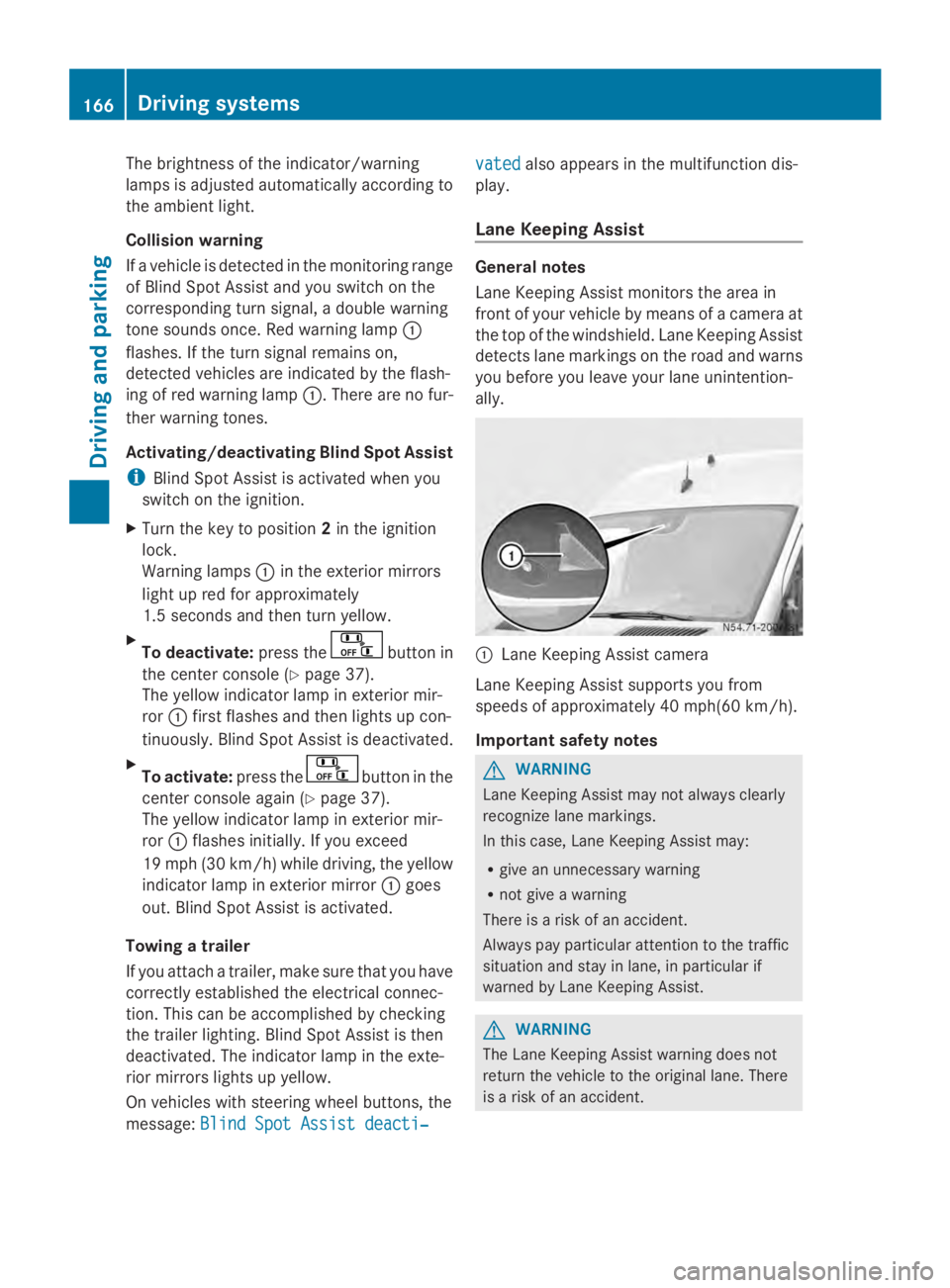
The brightness of the indicator/warning
lamps is adjusted automatically according to
the ambient light.
Collision warning
If a vehicle is detected in the monitoring range
of Blind Spot Assist and you switch on the
corresponding turn signal, a double warning
tone sounds once. Red warning lamp 0043
flashes. If the turn signal remains on,
detected vehicles are indicated by the flash-
ing of red warning lamp 0043. There are no fur-
ther warning tones.
Activating/deactivating Blind Spot Assist
i Blind Spot Assist is activated when you
switch on the ignition.
X Turn the key to position 2in the ignition
lock.
Warning lamps 0043in the exterior mirrors
light up red for approximately
1.5 seconds and then turn yellow.
X To deactivate: press the button in
the center console (Y page 37).
The yellow indicator lamp in exterior mir-
ror 0043first flashes and then lights up con-
tinuously. Blind Spot Assist is deactivated.
X To activate: press the button in the
center console again (Y page 37).
The yellow indicator lamp in exterior mir-
ror 0043flashes initially. If you exceed
19 mph (30 km/h) while driving, the yellow
indicator lamp in exterior mirror 0043goes
out. Blind Spot Assist is activated.
Towing a trailer
If you attach a trailer, make sure that you have
correctly established the electrical connec-
tion. This can be accomplished by checking
the trailer lighting. Blind Spot Assist is then
deactivated. The indicator lamp in the exte-
rior mirrors lights up yellow.
On vehicles with steering wheel buttons, the
message: Blind Spot Assist deacti‐
Blind Spot Assist deacti‐ vated vated
also appears in the multifunction dis-
play.
Lane Keeping Assist General notes
Lane Keeping Assist monitors the area in
front of your vehicle by means of a camera at
the top of the windshield. Lane Keeping Assist
detects lane markings on the road and warns
you before you leave your lane unintention-
ally.
0043
Lane Keeping Assist camera
Lane Keeping Assist supports you from
speeds of approximately 40 mph(60 km/h).
Important safety notes G
WARNING
Lane Keeping Assist may not always clearly
recognize lane markings.
In this case, Lane Keeping Assist may:
R give an unnecessary warning
R not give a warning
There is a risk of an accident.
Always pay particular attention to the traffic
situation and stay in lane, in particular if
warned by Lane Keeping Assist. G
WARNING
The Lane Keeping Assist warning does not
return the vehicle to the original lane. There
is a risk of an accident. 166
Driving systemsDriving and parking
Page 169 of 338
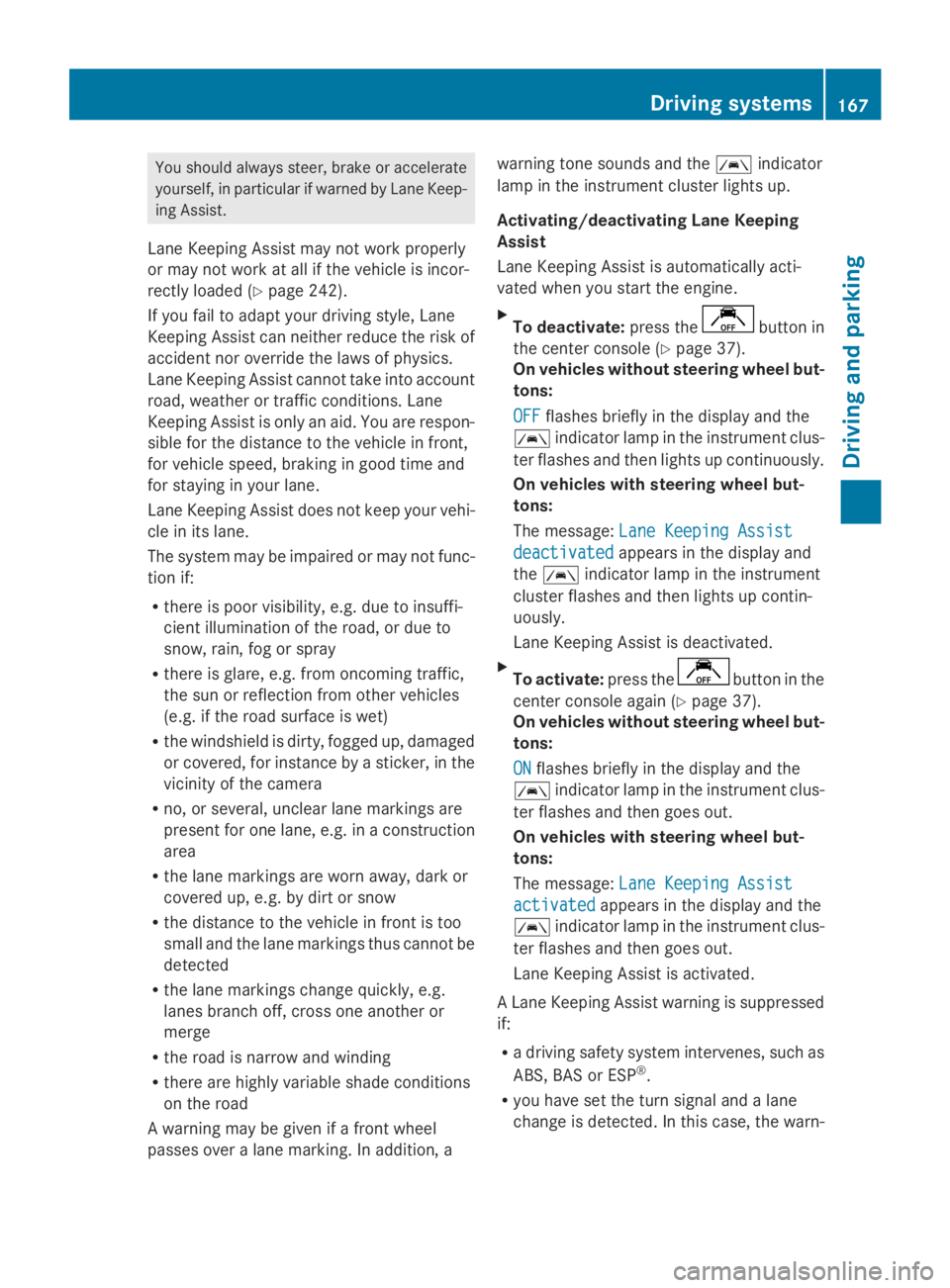
You should always steer, brake or accelerate
yourself, in particular if warned by Lane Keep-
ing Assist.
Lane Keeping Assist may not work properly
or may not work at all if the vehicle is incor-
rectly loaded (Y page 242).
If you fail to adapt your driving style, Lane
Keeping Assist can neither reduce the risk of
accident nor override the laws of physics.
Lane Keeping Assist cannot take into account
road, weather or traffic conditions. Lane
Keeping Assist is only an aid. You are respon-
sible for the distance to the vehicle in front,
for vehicle speed, braking in good time and
for staying in your lane.
Lane Keeping Assist does not keep your vehi-
cle in its lane.
The system may be impaired or may not func-
tion if:
R there is poor visibility, e.g. due to insuffi-
cient illumination of the road, or due to
snow, rain, fog or spray
R there is glare, e.g. from oncoming traffic,
the sun or reflection from other vehicles
(e.g. if the road surface is wet)
R the windshield is dirty, fogged up, damaged
or covered, for instance by a sticker, in the
vicinity of the camera
R no, or several, unclear lane markings are
present for one lane, e.g. in a construction
area
R the lane markings are worn away, dark or
covered up, e.g. by dirt or snow
R the distance to the vehicle in front is too
small and the lane markings thus cannot be
detected
R the lane markings change quickly, e.g.
lanes branch off, cross one another or
merge
R the road is narrow and winding
R there are highly variable shade conditions
on the road
A warning may be given if a front wheel
passes over a lane marking. In addition, a warning tone sounds and the
00B0indicator
lamp in the instrument cluster lights up.
Activating/deactivating Lane Keeping
Assist
Lane Keeping Assist is automatically acti-
vated when you start the engine.
X To deactivate: press the button in
the center console (Y page 37).
On vehicles without steering wheel but-
tons:
OFF OFF flashes briefly in the display and the
00B0 indicator lamp in the instrument clus-
ter flashes and then lights up continuously.
On vehicles with steering wheel but-
tons:
The message: Lane Keeping Assist Lane Keeping Assist
deactivated
deactivated appears in the display and
the 00B0 indicator lamp in the instrument
cluster flashes and then lights up contin-
uously.
Lane Keeping Assist is deactivated.
X To activate: press the button in the
center console again (Y page 37).
On vehicles without steering wheel but-
tons:
ON ON flashes briefly in the display and the
00B0 indicator lamp in the instrument clus-
ter flashes and then goes out.
On vehicles with steering wheel but-
tons:
The message: Lane Keeping Assist Lane Keeping Assist
activated
activated appears in the display and the
00B0 indicator lamp in the instrument clus-
ter flashes and then goes out.
Lane Keeping Assist is activated.
A Lane Keeping Assist warning is suppressed
if:
R a driving safety system intervenes, such as
ABS, BAS or ESP ®
.
R you have set the turn signal and a lane
change is detected. In this case, the warn- Driving systems
167Driving and parking Z
Page 170 of 338
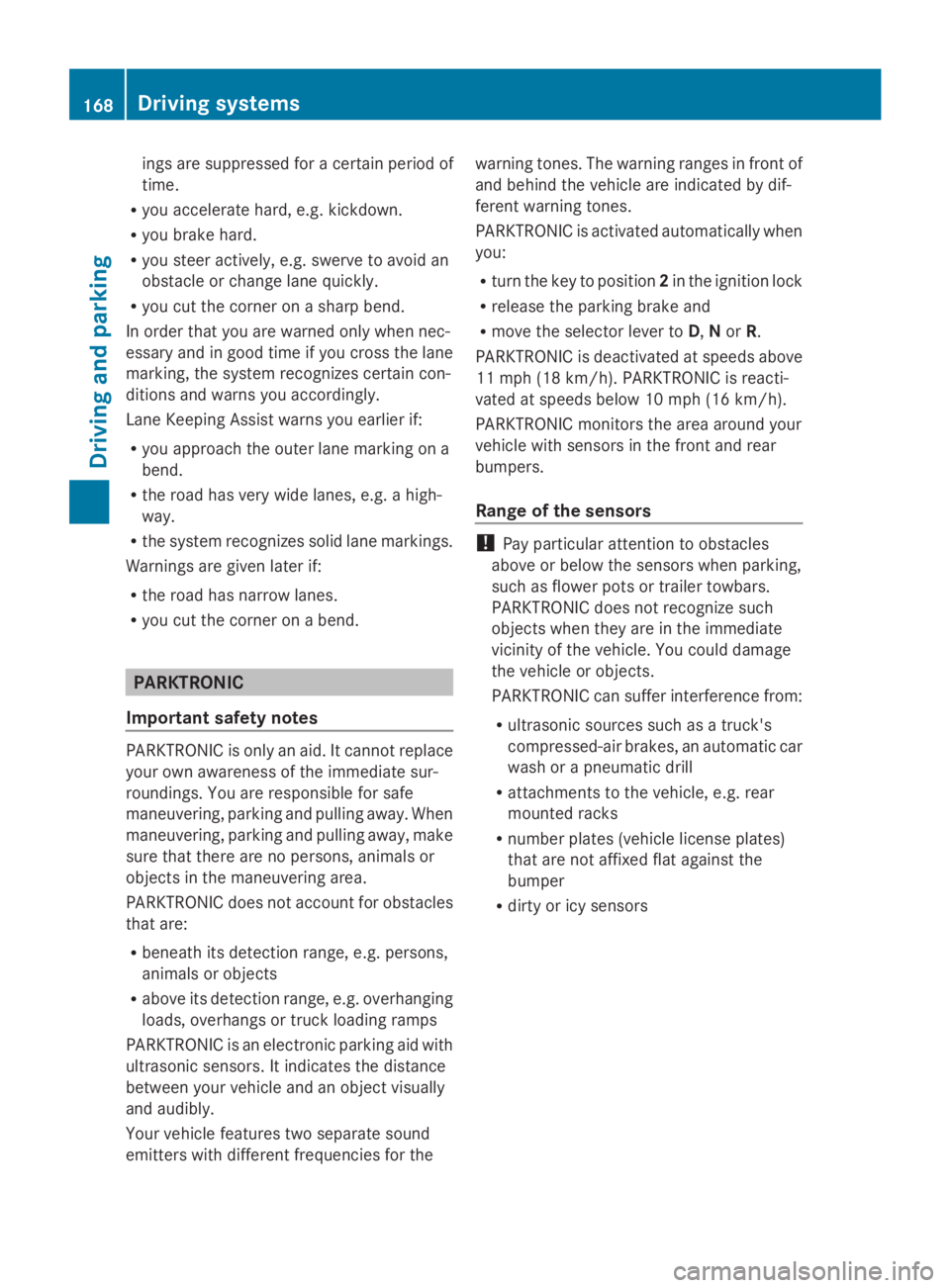
ings are suppressed for a certain period of
time.
R you accelerate hard, e.g. kickdown.
R you brake hard.
R you steer actively, e.g. swerve to avoid an
obstacle or change lane quickly.
R you cut the corner on a sharp bend.
In order that you are warned only when nec-
essary and in good time if you cross the lane
marking, the system recognizes certain con-
ditions and warns you accordingly.
Lane Keeping Assist warns you earlier if:
R you approach the outer lane marking on a
bend.
R the road has very wide lanes, e.g. a high-
way.
R the system recognizes solid lane markings.
Warnings are given later if:
R the road has narrow lanes.
R you cut the corner on a bend. PARKTRONIC
Important safety notes PARKTRONIC is only an aid. It cannot replace
your own awareness of the immediate sur-
roundings. You are responsible for safe
maneuvering, parking and pulling away. When
maneuvering, parking and pulling away, make
sure that there are no persons, animals or
objects in the maneuvering area.
PARKTRONIC does not account for obstacles
that are:
R beneath its detection range, e.g. persons,
animals or objects
R above its detection range, e.g. overhanging
loads, overhangs or truck loading ramps
PARKTRONIC is an electronic parking aid with
ultrasonic sensors. It indicates the distance
between your vehicle and an object visually
and audibly.
Your vehicle features two separate sound
emitters with different frequencies for the warning tones. The warning ranges in front of
and behind the vehicle are indicated by dif-
ferent warning tones.
PARKTRONIC is activated automatically when
you:
R turn the key to position 2in the ignition lock
R release the parking brake and
R move the selector lever to D,Nor R.
PARKTRONIC is deactivated at speeds above
11 mph (18 km/h). PARKTRONIC is reacti-
vated at speeds below 10 mph (16 km/h).
PARKTRONIC monitors the area around your
vehicle with sensors in the front and rear
bumpers.
Range of the sensors !
Pay particular attention to obstacles
above or below the sensors when parking,
such as flower pots or trailer towbars.
PARKTRONIC does not recognize such
objects when they are in the immediate
vicinity of the vehicle. You could damage
the vehicle or objects.
PARKTRONIC can suffer interference from:
R ultrasonic sources such as a truck's
compressed-air brakes, an automatic car
wash or a pneumatic drill
R attachments to the vehicle, e.g. rear
mounted racks
R number plates (vehicle license plates)
that are not affixed flat against the
bumper
R dirty or icy sensors 168
Driving systemsDriving and parking
Page 204 of 338
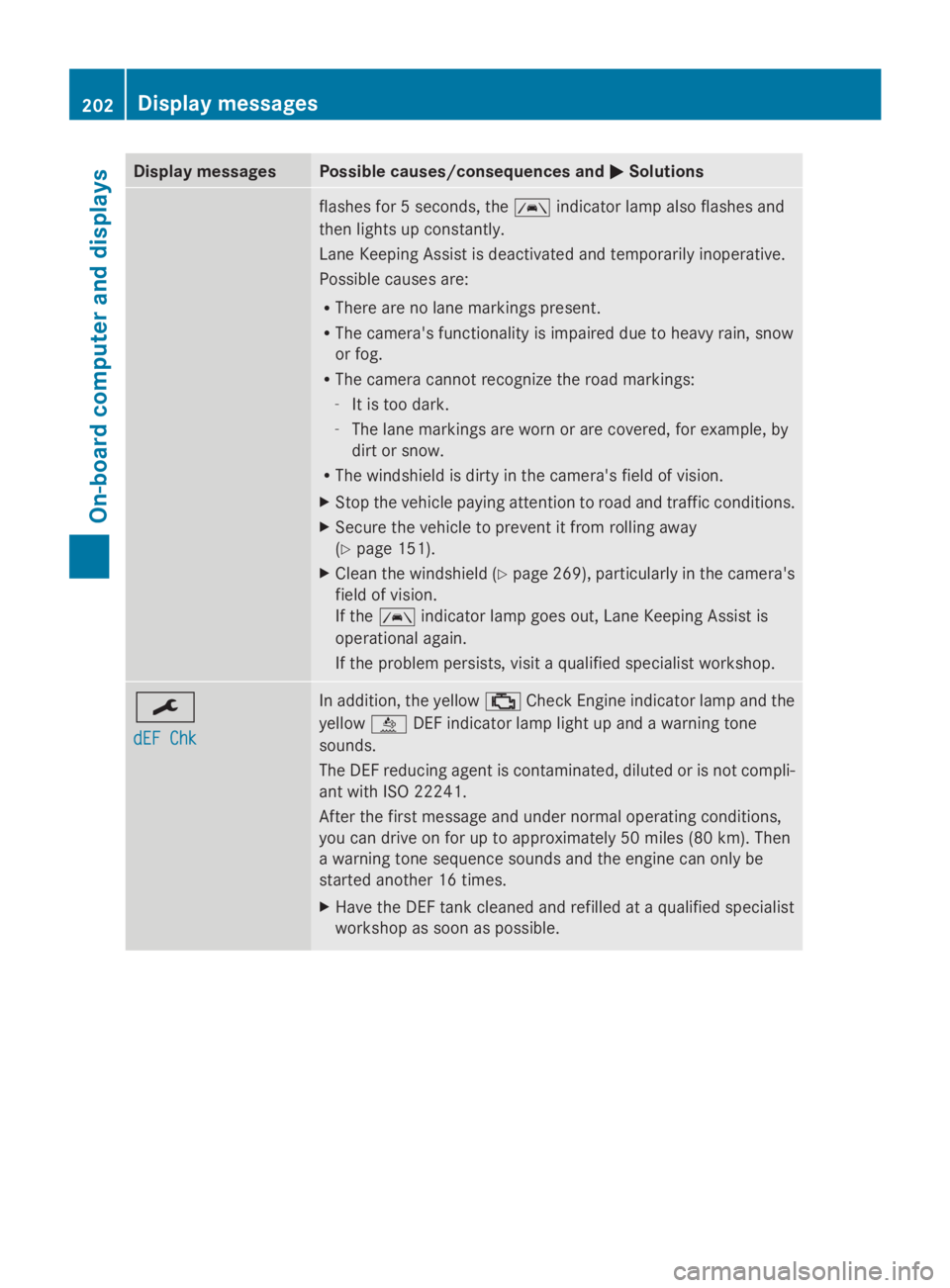
Display messages Possible causes/consequences and
0050
0050Solutions flashes for 5 seconds, the
00B0indicator lamp also flashes and
then lights up constantly.
Lane Keeping Assist is deactivated and temporarily inoperative.
Possible causes are:
R There are no lane markings present.
R The camera's functionality is impaired due to heavy rain, snow
or fog.
R The camera cannot recognize the road markings:
- It is too dark.
- The lane markings are worn or are covered, for example, by
dirt or snow.
R The windshield is dirty in the camera's field of vision.
X Stop the vehicle paying attention to road and traffic conditions.
X Secure the vehicle to prevent it from rolling away
(Y page 151).
X Clean the windshield (Y page 269), particularly in the camera's
field of vision.
If the 00B0 indicator lamp goes out, Lane Keeping Assist is
operational again.
If the problem persists, visit a qualified specialist workshop. 0099
dEF Chk dEF Chk In addition, the yellow
00B9Check Engine indicator lamp and the
yellow 00E2DEF indicator lamp light up and a warning tone
sounds.
The DEF reducing agent is contaminated, diluted or is not compli-
ant with ISO 22241.
After the first message and under normal operating conditions,
you can drive on for up to approximately 50 miles (80 km). Then
a warning tone sequence sounds and the engine can only be
started another 16 times.
X Have the DEF tank cleaned and refilled at a qualified specialist
workshop as soon as possible. 202
Display
messagesOn-board computer and displays